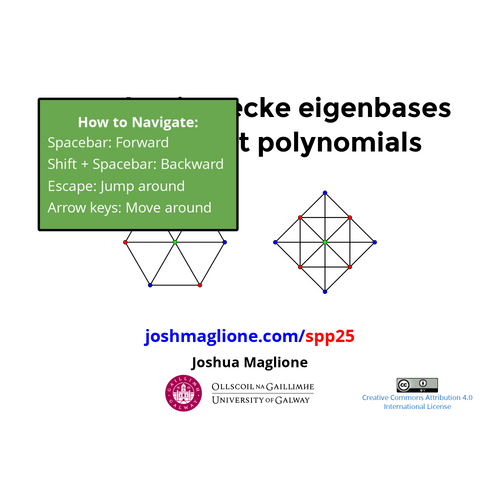Isomorphism via derivations
Joshua Maglione
Universität Bielefeld
jmaglione@math.uni-bielefeld.de
(This talk is being recorded.)


Joint with...
Goal: \(G, H\leq \mathrm{GL}_d(\mathbb{F}_q)\) decide if \(G\cong H\) in \((d\log q)^{O(1)}\) steps.
A bottleneck example
Related: Are \((2, 7, 6)\) and \((3, 8, 4)\) intrinsic to \(G\) and \(H\)?
Example: \(K = \mathbb{F}_q\) and
Apply Cannon, Holt (2003) and Eick et al. (2002).
Work, via induction, down characteristic filtration:
where \(\eta_{i+1} = \eta_i^p[\eta_i, G]\).
Decide which \(G/\eta_i \overset{\cong}{\longrightarrow} H/\eta_i\) lifts to a \(G/\eta_{i+1} \overset{\cong}{\longrightarrow} H/\eta_{i+1}\).
Our Example: \(G/\Phi(G) \cong H/\Phi(H) \cong K^{56}\).
Search through \(\mathrm{GL}_{56}(K)\), has order \(\approx q^{3136}\).
Maybe can construct nontrivial characteristic subgroups (i.e. fixed by every automorphism).
Use these to produce more by refining a generalized filtration (M. (2017, 2021), Wilson (2013)).
Not always possible


Refine
Bilinear maps and derivations
Each \(s, t\in \mathbb{N}\) , defines \(\mathbb{F}_p\)-bilinear map:
Easier: decide isomorphism of bilinear maps, instead.
Find \((\alpha,\beta, \gamma)\in \mathrm{GL}(U)\times \mathrm{GL}(V)\times \mathrm{GL}(W)\) such that

The Lie algebra of derivations for \(t : U\times V \rightarrow W\) is
where \(\mathfrak{L} = \mathfrak{gl}(U)\times \mathfrak{gl}(V) \times \mathfrak{gl}(W)\).
The densor space (derivation tensor) is
Our Example:
\(1\)-dim. densors.
Efficiency with tiny densors
- "Algorithm" = Las Vegas + factoring oracles in \(\mathbb{Z}, \mathbb{Q}[x]\).
- "Chevalley type" = derived subalgebra has Chevalley basis.
Theorem (Brooksbank, M, Wilson (2020)).
Let \(K = 6K\) or \(K/\mathbb{Q}\) be finite. There exists an algorithm that, given nondegenerate \(s, t : K^a\times K^b \rightarrow K^c\) with \(\mathfrak{Der}(t)\) of Chevalley type, \(\mathrm{im}(t)=K^c\), and \(\dim(\hspace{-0.77mm}|t|\hspace{-0.77mm})=1\), decides \(s\cong t\) in \((a+b+c)^{O(1)}\) steps.
\(\exists\) more associative way?
Example: \(\mathfrak{sl}_n\) acts on \(K^n\). Determines \(t: \mathfrak{sl}_n\times K^n \rightarrow K^n\).



Usual suspects do not help, yet \(\dim(\hspace{-0.77mm}|t|\hspace{-0.77mm}) = 1\).
But sometimes associative algebras are enough.
Core idea of isomorphism test based on:

Theorem (Brooksbank, M, Wilson (2017)).
There exists an algorithm that, given class 2 \(p\)-groups \(G, H\) of exponent \(p\) with \(G'\cong H' \cong \mathbb{F}_p^2\), decides if \(G\cong H\) in \((p + \log|G|)^{O(1)}\) steps.
Densor is densest
Derivations "satisfy" the polynomial \(x + y - z\).
The densor space is the \(P\)-closure, for \(P=(x+y-z)\).
For every ideal \(P\), there is a corresponding \(P\)-closure.
Theorem (First, M, Wilson (2020)).
For every homogeneous linear ideal \(P\subset K[x,y,z]\), the densor embeds into the \(P\)-closure, provided the bilinear map is nondegenerate and image = codomain.
Densors are smallest; computed only with linear algebra.
A family of tiny densors
Let \(L=\mathfrak{sl}_{n+1}(K)\) be simple, and \(V\) a simple \(L\)-module.
Finite dimensional \(L\)-modules determined by partitions \(\lambda\).
Lemma. If \(V\cong V(\lambda)\), then \(\dim(\hspace{-0.77mm}|t|\hspace{-0.77mm})\) is the number of "corners" of \(\lambda\). In particular, \(\dim(\hspace{-0.77mm}|t|\hspace{-0.77mm}) \leq n\).

Derivation-densor method
Automorphism version: compute stabilizer instead.
The algorithm works regardless of our hypotheses:
Compute \(\mathfrak{Der}\) and \((\hspace{-0.77mm}|\cdot|\hspace{-0.77mm})\) for both \(s, t\).
Find invertible \(\varphi\) such that \(\varphi\mathfrak{Der}(s)\varphi^{-1} = \mathfrak{Der}(t)\).
Construct gens for normalizer \(N := \mathrm{N}(\mathfrak{Der}(t))\).
Decide if \(s^{\varphi}\) and \(t\) in same \(N\)-orbit in \((\hspace{-0.77mm}|t|\hspace{-0.77mm})\).
1.
2.
3.
4.
Much work to find the conjugating element \(\varphi\).
Tiny densor \(\implies\) \(U, V, W\) simple \(\mathfrak{Der}\)-mods.
Decompose: \(\mathfrak{Der}(t) = M_0\oplus M_1\oplus \cdots \oplus M_r\) (Ivanyos et al. (2012)).
Decide conjugacy on abelians (Brooksbank, Wilson (2015)).
Apply de Graaf (2000), Ryba (2007), Magaard, (R. A.) Wilson (2012) to get Chevalley basis.
Tensor decompose \(U, V, W\).
Decide conjugacy of simple Lie modules of simple Lie algebras (Grochow (2012)).
Tiny densor \(\implies\) gens for \(\mathrm{N}(\mathfrak{Der})\) not required.
When \(K\) is finite, can construct automorphisms.
Derivation-densor method applies more generally.
Question. Which conditions can be relaxed without losing polynomial time?
Warning: Grochow proved general conjugacy of Lie modules is as hard as Graph Isomorphism (2012).
- \(\dim (\hspace{-0.77mm}|t|\hspace{-0.77mm})\geq 2\)?
- Non-Chevalley simples?
Derivations find a shortcut
Nilpotent groups may lack characteristic structure.
Derivation-densor generalizes previous isomorphism tests and is the most "optimal."
Groups with tiny densors have large \(\mathrm{Aut}\) of Lie-type.
Derivation-densor is polynomial time with tiny densors and Chevalley type.
Shows potential to be polynomial time on larger families.
Isomorphism via derivations
By Josh Maglione
Isomorphism via derivations
By bringing in tools from multilinear algebra, we introduce a general method to aid in the computation of group isomorphism. Of particular interest are nilpotent groups where the only classically known proper nontrivial characteristic subgroup is the derived subgroup. Through structural analysis of the biadditive commutator map, we leverage the representation theory of Lie algebras to prove efficiency for families of nilpotent groups. We report on joint work with Peter A. Brooksbank, and James B. Wilson.
- 1,290




